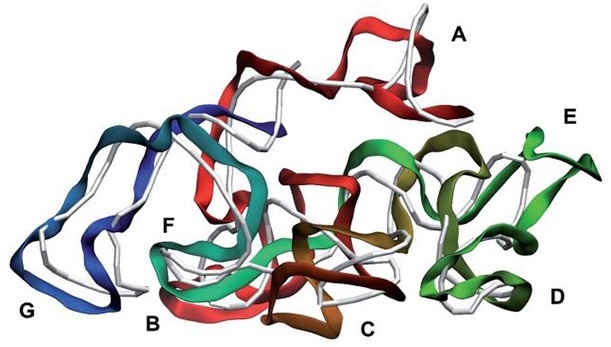An Aston University scientist has developed the world’s first computer reconstruction of a virus, complete with its native genome.
 Segment of reconstructed genome model (red to green to blue), placed over the cryo-EM backbone (white). Image Credit: Dr Dmitry Nerukh.
Segment of reconstructed genome model (red to green to blue), placed over the cryo-EM backbone (white). Image Credit: Dr Dmitry Nerukh.
Even though comparable reconstructions have been created by other scientists, this is the first time to recreate the actual chemical and 3D structure of a “live” virus.
The discovery could pave the way for research into antibiotic alternatives, minimizing the threat of anti-bacterial resistance.
Dr Dmitry Nerukh of the Department of Mathematics in the College of Engineering and Physical Sciences at Aston University carried out the research. The observations have been published in the journal Faraday Discussions.
The study used existing data from cryo-EM measurements of virus structures and computational modeling, which took nearly three years despite the use of supercomputers in the UK and Japan.
The discovery will allow biologists to explore biological processes that are currently inaccessible due to the virus model’s lack of a genome.
This includes determining how a bacteriophage, a type of virus that infects bacteria, kills a particular disease-causing bacterium.
It is unknown how this occurs at the moment, but this new method of creating more accurate models will allow for more investigation into using bacteriophages to destroy specific life-threatening bacteria.
This might result in more targeted treatment of illnesses presently treated with antibiotics, helping to combat the growing threat of antibiotic resistance to humans.
Up till now no one else had been able to build a native genome model of an entire virus at such detailed (atomistic) level. The ability to study the genome within a virus more clearly is incredibly important. Without the genome it has been impossible to know exactly how a bacteriophage infects a bacterium. This development will now allow help virologists answer questions which previously they couldn’t answer.”
Dr Dmitry Nerukh, Department of Mathematics, College of Engineering and Physical Sciences, Aston University
Dr Dmitry Nerukh concludes, “This could lead to targeted treatments to kill bacteria which are dangerous to humans, and to reduce the global problem of antibiotic-resistant bacteria which are over time becoming more and more serious.”
The modeling approach used by the group has numerous other potential applications. One of these is the development of computational reconstructions to aid cryo-electron microscopy, a technique used to analyze life forms that have been cooled to an extreme temperature.
Source:
Journal reference:
Farafonov, V. S., et al. (2022) Reconstruction and validation of entire virus model with complete genome from mixed resolution cryo-EM density. Faraday Discussions. doi.org/10.1039/D2FD00053A.